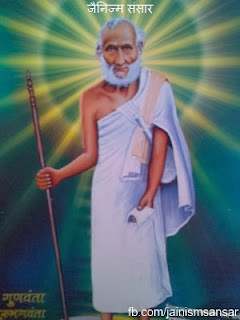"जिस घर में गुरुदेव कि तस्वीर हैं
उस घर कि बदल गयी तकदीर हैं
जिस घर में बिराजे गुरु कि मूरत
उस घर में हमेशा हँसती रहे हर सूरत"
Acharya Rajendrasuri (1827-1906) was the major reformer of 18th and 19th century in Shvetambar sect of Jainism. Acharya Rajendrasuri born on 3rd dec.1827 at Bharatpur in Rajasthan. In 1880 A.D., as the leader of the Tapa Gachchha, lead a movement to restore orders of wandering monks, leading to near extinction of the Jain Yati institutions. Afterwords he restore shraman sanstha by reopening of Agam gachchha or Samakit gachchha,now that is konwn as 'Tristutik' gachchha. He opposed worship of various minor gods and goddesses inspite of Jain Tirthankars.
He wrotte many books on Jainism his one of the most famous achievement is 'Aabhidhan Rajendra Kosh' that is only one available Jain encyclopedia or Jain dictionary of Prakrit,Sanskrit,and Palee Jain languages words (used by Jainism).
Rajendrasuri did not end at the reformation of the Jain yati institution, it was his first task of revival movement. His other achievements were restoration and reconstruction of Jain temples and installation of Jain images and establishment of different socio-religious organizations for the uplift of the Jains and propagation of Jainism. Like a pious, true, diligent monk, devoted to the cause of Jainism. He walked from place to place in Rajasthan, Gujarat, Malwa, etc. teaching, preaching and infusing new spirit of the age among the people. He appealed to the masses by delivering his discourses in simple dialects of the people, the common spoken languages of the masses, - Malwi, Gujarati, Marwari, etc. He inspired the Jain monks to study profoundly the Jain scriptures. He himself devoted to the deep study of Jain works. He was bitterly opposed to the storage of Jain works in isolated places; he eagerly desired to bring them to light for the propagation of Jainism. He himself wrote collected and edited certain important Jain works. He complied the famous Jain encyclopedia 'Abhidan-Rajendra Kosh'. It is a monumental work in seven volumes with more then 90 thousand pages. This work itself places Rajendrasuri on a high pedestal of Jain scholars and pioneers of religious movements of the nineteenth century.














.jpg)
.jpg)
.jpg)
.jpg)


टिप्पणियाँ
एक टिप्पणी भेजें